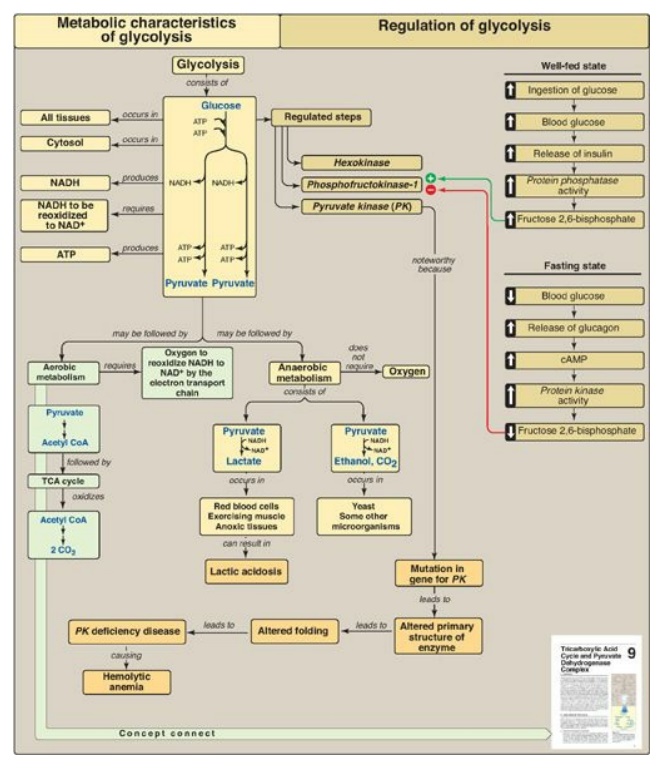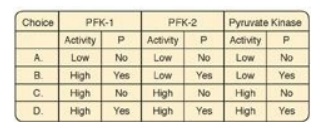Chapter Summary, Study Questions
| Home | | Biochemistry |Chapter: Biochemistry : Introduction to Metabolism and Glycolysis
Most pathways can be classified as either catabolic (degrade complex molecules to a few simple products) or anabolic (synthesize complex end products from simple precursors).
CHAPTER SUMMARY
Most pathways can be
classified as either catabolic (degrade complex molecules to a few simple
products) or anabolic (synthesize complex end products from simple precursors).
Catabolic reactions also capture chemical energy in the form of ATP from the
degradation of energy-rich molecules. Anabolic reactions require energy, which
is generally provided by the hydrolysis of ATP. The rate of a metabolic pathway
can respond to regulatory signals such as allosteric activators or inhibitors
that arise from within the cell. Signaling between cells provides for the
integration of metabolism. The most important route of this communication is
chemical signaling (for example, by hormones or neurotransmitters). Second
messenger molecules transduce a chemical signal (hormone or neurotransmitter)
to appropriate intracellular responders. Adenylyl cyclase is a cell membrane
enzyme that synthesizes cyclic AMP (cAMP) in response to chemical signals, such
as the hormones glucagon and epinephrine. Following binding of a hormone to its
cell-surface receptor, a GTP-dependent regulatory protein (G protein) is
activated that, in turn, activates adenylyl cyclase. The cAMP produced
activates a protein kinase, which phosphorylates a cadre of enzymes, causing
their activation or deactivation. Phosphorylation is reversed by protein
phosphatases. Aerobic glycolysis, in which pyruvate is the end product, occurs
in cells with mitochondria and an adequate supply of oxygen (Figure 8.25) .
Anaerobic glycolysis, in which lactic acid is the end product, occurs in cells
that lack mitochondria and in cells deprived of sufficient oxygen. Glucose is
transported across membranes by one of 14 glucose transporter isoforms (GLUTs).
GLUT-1 is abundant in erythrocytes and the brain, GLUT-4 (which is insulin
dependent) is found in muscle and adipose tissue, and GLUT-2 is found in the liver, kidney, and β cells of
the pancreas. The conversion of glucose to pyruvate (glycolysis; Figure 8.25)
occurs in two stages: an energy– investment phase in which phosphorylated
intermediates are synthesized at the expense of ATP, and an energy-generation
phase, in which ATP is produced. In the energy-investment phase, glucose is
phosphorylated by hexokinase (found in most tissues) or glucokinase (a
hexokinase found in liver cells and the β cells of the pancreas). Hexokinase
has a high affinity (low Km) and a low Vmax for glucose and is inhibited by
glucose 6-phosphate. Glucokinase has a high Km and a high Vmax for glucose. It
is indirectly inhibited by fructose 6-phosphate and activated by glucose. The
transcription of the gene for glucokinase is enhanced by insulin. Glucose
6-phosphate is isomerized to fructose 6-phosphate, which is phosphorylated to
fructose 1,6-bisphosphate by phosphofructokinase-1 (PFK-1). This enzyme is
allosterically inhibited by ATP and citrate and activated by AMP. Fructose
2,6-bisphosphate, whose synthesis by phosphofructokinase-2 (PFK-2) is activated
by insulin, is the most potent allosteric activator of PFK-1. A total of two
ATP are used during this phase of glycolysis. Fructose 1,6-bisphosphate is
cleaved to form two trioses that are further metabolized by the glycolytic
pathway, forming pyruvate. During these reactions, four ATP and two NADH are
produced from ADP and NAD+. The final step in pyruvate synthesis
from phosphoenolpyruvate is catalyzed by pyruvate kinase (PK). This enzyme is
allosterically activated by fructose 1,6-bisphosphate and hormonally activated
by insulin and inhibited in the liver by glucagon via the cAMP pathway. PK
deficiency accounts for the majority of all inherited defects in glycolytic
enzymes. Effects are restricted to erythrocytes and present as mild to severe
chronic, nonspherocytic hemolytic anemia. In anaerobic glycolysis, NADH is
reoxidized to NAD+ by the conversion of pyruvate to lactate. This
occurs in cells, such as erythrocytes, that have few or no mitochondria, and in
tissues, such as exercising muscle, where production of NADH exceeds the
oxidative capacity of the respiratory chain. Elevated concentrations of lactate
in the plasma (lactic acidosis) occur when there is a collapse of the
circulatory system or when an individual is in shock. Pyruvate can be 1)
oxidatively decarboxylated by pyruvate dehydrogenase, producing acetyl coenzyme
A; 2) carboxylated to oxaloacetate (a tricarboxylic acid cycle intermediate) by
pyruvate carboxylase; or 3) reduced by microorganisms to ethanol by pyruvate
decarboxylase.

Figure 8.25 Key concept map for glycolysis. NAD(H) = nicotinamide adenine dinucleotide; cAMP = cyclic adenosine monophosphate; CoA = coenzyme A; TCA = tricarboxylic acid.
Study Questions
Choose the ONE best answer.
8.1 Which of the following best describes the
activity level and phosphorylation state of the listed hepatic enzymes in an
individual who consumed a carbohydrate-rich meal about an hour ago? PFK-1 =
phosphofructokinase-1; PFK-2 = phosphofructokinase-2; P = phosphorylated.

Correct answer = C. In the period immediately
following a meal, blood glucose levels and hepatic uptake of glucose increase.
The glucose is phosphorylated to glucose 6-phosphate and used in glycolysis. In
response to the rise in blood glucose, the insulin-to-glucagon ratio increases.
As a result, the kinase domain of PFK-2 is dephosphorylated and active. Its
product, fructose 2,6-bisphosphate, allosterically activates PFK-1. (PFK-1 is
not covalently regulated.) Active PFK-1 produces fructose 1,6-bisphosphate that
is a feedforward activator of pyruvate kinase. Hepatic pyruvate kinase is
covalently regulated, and the rise in insulin favors dephosphorylation.
8.2 Which of the following statements is true for
anabolic pathways only?
A. Their irreversible
(nonequilibrium) reactions are regulated.
B. They are called
cycles if they regenerate an intermediate.
C. They are convergent
and generate a few simple products.
D. They are synthetic and require energy.
E. They typically
require oxidized coenzymes.
Correct answer = D. Anabolic processes are synthetic
and energy requiring (endergonic). Statements A and B apply to both anabolic
and catabolic processes, whereas C and E apply only to catabolic processes.
8.3 Compared with the resting state, vigorously
contracting skeletal muscle shows:
A. decreased AMP/ATP
ratio.
B. decreased levels of
fructose 2,6-bisphosphate.
C. decreased NADH/NAD+
ratio.
D. increased oxygen
availability.
E. increased reduction of pyruvate to lactate.
Correct answer = E. Vigorously contracting muscle
shows an increase in the reduction of pyruvate to lactate compared with resting
skeletal muscle. The levels of adenosine monophosphate (AMP) and reduced
nicotinamide adenine dinucleotide (NADH) increase, whereas change in the
concentration of fructose 2,6-bisphosphate is not a key regulatory factor in
skeletal muscle. The rise in the NADH to NAD+ ratio exceeds the
oxidative capacity of the respiratory chain.
8.4 Glucose uptake by:
A. liver cells is through facilitated diffusion
involving a glucose transporter.
B. intestinal mucosal
cells requires insulin.
C. brain cells is
through energy-requiring (active) transport.
D. most cells is
through simple diffusion up a concentration gradient.
Correct answer = A. Glucose uptake in the liver,
brain, muscle, and adipose tissue is down a concentration gradient, and the
diffusion is facilitated by tissue-specific glucose transporters (GLUTs). In
adipose and muscle, insulin is required for glucose uptake. Moving glucose
against a concentration gradient requires energy, and is seen with
sodium-dependent glucose transporter-1 (SGLT-1) of intestinal mucosal cells.
8.5 Given that the Km of glucokinase for glucose is
10 mM whereas that of hexokinase is 0.1 mM, which isozyme will more closely
approach Vmax at the normal blood glucose concentration of 5 mM?
Correct answer = Hexokinase. Km is that substrate
concentration that gives 1⁄2 Vmax. When blood glucose concentration
is 5 mM, hexo-kinase (Km = 0.1 mM) will be saturated, but
glucokinase (K m = 10 mM) will not.
8.6 In patients with whooping cough, Gαi is
inhibited. How does this lead to a rise in cyclic AMP?
Liganded G proteins of the Gαi type inhibit
adenylyl cyclase. If Gαi is inhibited by toxin, adenylyl cyclase
production of cyclic adenosine monophosphate (cAMP) is inappropriately
activated.
Related Topics
